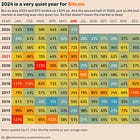Slow and steady: MicroStrategy’s macro strategy
Also debt for growth and PCE inflation vs the Fed
Welcome to the Friday edition of the Ecoinometrics newsletter.
Every week we bring you the three most important charts on the topics of macroeconomics, Bitcoin and digital assets.
Today we'll cover:
Slow and steady: MicroStrategy’s macro strategy
Will exchange debt for growth
PCE inflation vs the Federal Reserve
Each topic comes with a small explanation and one big chart. So let’s dive in.
In case you missed it, here are the other topics we covered this week:
If you aren’t subscribed yet, hit the subscribe button, to receive this email every week directly in your inbox:
Slow and steady: MicroStrategy’s macro strategy
One more month to go and MicroStrategy will have regularly bought Bitcoins for its treasury strategy for four years.
On the chart below you can see the evolution of the total amount of coins they hold over time. If you exclude the depth of the bear market in 2022, MicroStrategy has been accumulating coins at a steady pace. As a result they hold more than 1% of all the Bitcoins that will ever be created. Only two ETFs hold more coins that MicroStrategy GBTC (Grayscale) and IBIT (BlackRock).
MicroStrategy’s tactic is pretty straightforward. At first they leveraged their cash and a very public presence of Michael Saylor to build an initial position. Since then they have been using that initial position and the fact MSTR stock value is tied to it in order to acquire more coins via debt.
That’s a bit of an extreme strategy. You cannot have all public companies become Bitcoin holding companies as their primary business. But given MSTR success I bet we might see more than a few public companies start to diversify their holdings by getting at least some exposure to Bitcoin.
Will exchange debt for growth
The US economy is growing, but at what cost? The US economy might be doing better than everyone else but that doesn’t mean it is built on solid ground.
Since 1977 we've seen the US debt-to-GDP ratio climb steadily. It's now over 125%. This means the country owes more than it produces in a year.
Since 2001, the government has run a deficit every single year. This isn't just during crises. It's become the norm.
The Great Recession caused a sharp rise in debt. But even as the economy recovered, the debt kept growing. The COVID-19 pandemic pushed it even higher.
Now, even in good economic times, the debt is still rising faster than GDP growth.
Even Fed Chairman Jay Powell is starting to publicly worry about this: “You can’t run these levels [of deficit] in good economic time for very long” and “[there are risks in] running a very large deficit at a time when we are at full employment”.
The colour scale shows GDP growth rates. Notice how periods of high growth (red) haven't led to debt reduction. Instead, the government seems to be exchanging more debt for growth.
This strategy might boost the economy short-term. But it raises questions about long-term financial stability. How long can this continue? What are the risks this strategy leads to a dead-end?
PCE inflation vs the Federal Reserve
The Federal Reserve's inflation target seems to be in sight. This chart shows PCE inflation trends, a key measure the Fed watches closely.
Headline and Core PCE inflation have both dropped to 2.6%. This is a significant improvement from the highs we saw in 2022. It's also right where the Fed expects inflation to be this year.
But Core Services inflation is still high at 3.4%. This measure is important because it can be stubborn to bring down.
Since 2023 all measures have been trending downward. Headline inflation, which includes volatile food and energy prices, has fallen the most dramatically.
Core inflation, which excludes food and energy, has followed a similar but smoother path. It's now aligned with the headline figure.
The Federal Reserve's efforts to cool the economy seem to be working. But the job isn't done yet. Core Services inflation remains a concern.
Looking ahead, the Fed will likely keep a close eye on these trends. They'll be watching to see if inflation continues to move towards their 2% target.
But as we have discussed in the previous section, the Federal Reserve might become more concerned about the US debt than inflation. In that case they are more likely to cut rates whether or not inflation can settle down to 2%.
That’s it for today. I hope you enjoyed this. We’ll be back next week with more charts.
Cheers,
Nick
P.S. We spend the entire week, countless hours really, doing research, exploring data, surveying emerging trends, looking at charts and making infographics.
Our objective? Deliver to you the most important insights in macroeconomics, Bitcoin and digital assets.
Armed with those insights you can make better investment decisions.
Are you a serious investor? Do you want to get the big picture to get on the big trades? Then click on the button below.






